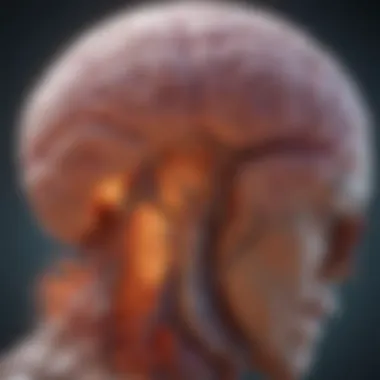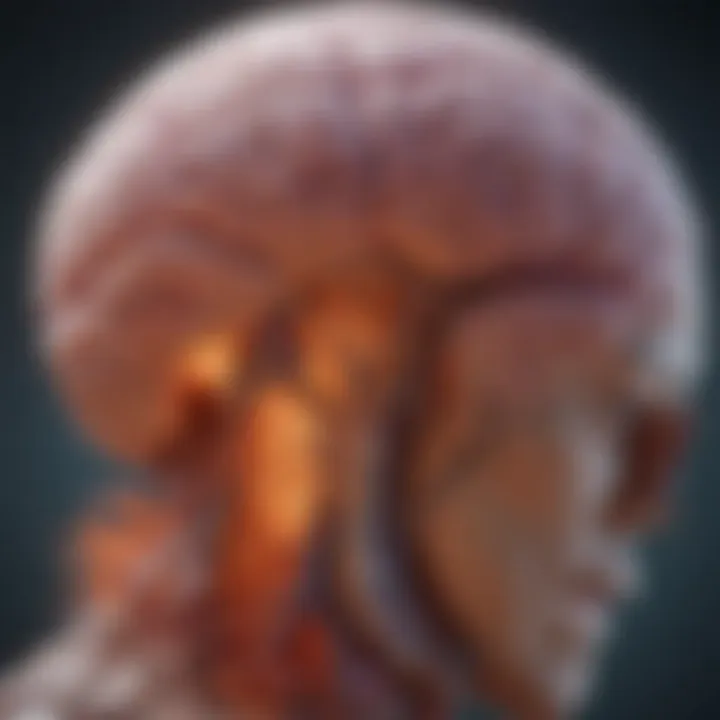Exploring Refractory Glioblastoma: Challenges and Advances


Intro
Refractory glioblastoma is a formidable adversary in the landscape of neuro-oncology. This form of brain cancer is infamous for its resistance to conventional therapies, leading to disheartening outcomes for patients. The unique biological characteristics of refractory glioblastoma complicate treatment strategies, making it essential to explore not only the underlying mechanisms but also advances in therapeutic approaches.
Understanding the depth of this topic requires a detailed examination of both established clinical frameworks and pioneering research. The exploration encompasses a multitude of aspects, including tumor biology, patient-specific factors, and the role of novel treatment modalities. This article endeavors to shed light on these critical areas, aiming to provide a comprehensive overview that is both informative and insightful.
Significant strides have been made in research methodologies and therapeutic strategies, with the potential to reshape the management of this aggressive malignancy. Personalized medicine emerges as a key player, emphasizing the need for tailored treatments that address the complexities of each individual case.
The ensuing sections will delve into the specific challenges associated with refractory glioblastoma, while also highlighting recent advances that offer hope for improved patient outcomes. By synthesizing the information gathered from current studies, clinical trials, and novel approaches, a clearer picture of where we stand—and where we are headed—will be presented, guiding both research and clinical practice in their efforts to combat this relentless disease.
Understanding Refractory Glioblastoma
Refractory glioblastoma represents a significant challenge in neuro-oncology. Its reputation for resistance to conventional therapies and poor prognosis underscores the necessity of comprehensive understanding. This section highlights several critical elements that are vital for appreciating the nuances of this condition. Key considerations include the biological behavior of the tumor, implications for patient care, and avenues for innovative therapies.
Definition and Overview
Refractory glioblastoma is a form of glioblastoma multiforme that fails to respond to standard treatment protocols. This cancer originates in the glial cells of the brain and is known for rapid growth and infiltration into surrounding tissue. Refractory cases often arise after initial therapy has been administered, typically involving surgical removal and adjuvant therapies like chemotherapy and radiation.
Patients who experience refractory glioblastoma are in need of tailored treatments. Unfortunately, standard approaches may not yield favorable outcomes, thus necessitating ongoing research into more effective strategies. The characteristics of refractory glioblastoma include not only its resistance to treatment but also a tendency for increased recurrence and aggressive clinical behavior. As a result, understanding this tumor's fundamental properties becomes essential for developing new modalities of care.
Epidemiology of Glioblastoma
The epidemiology of glioblastoma highlights its impact within the neuro-oncological landscape. This malignancy represents the most common and deadliest primary brain tumor among adults. Globally, its incidence rate varies, but studies indicate a prevalence of approximately 3 to 5 cases per 100,000 individuals each year.
Several demographic factors influence the occurrence of glioblastoma. Age is a significant risk factor, with most patients diagnosed in their 60s. Moreover, there is a slight male predominance in the incidence of this cancer. Genetic background and environmental exposures have also been studied as contributing factors, yet the exact etiology remains largely unknown. Recent data suggest that glioblastoma's incidence is on the rise, further emphasizing the importance of targeted research and potential early intervention strategies.
"The understanding of epidemiological trends is crucial for strategizing public health approaches to manage glioblastoma effectively."
Pathophysiology of Refractory Glioblastoma
The pathophysiology of refractory glioblastoma is critical for understanding the complexity of this aggressive brain cancer. This section aims to elucidate the distinctive cellular characteristics, genetic alterations, and the tumor microenvironment that contribute to the unique behavior of refractory glioblastoma. Recognizing these elements helps elucidate why this tumor type resists standard treatments, potentially guiding more effective therapeutic strategies.
Cellular Characteristics
Refractory glioblastoma displays several notable cellular characteristics that differentiate it from other tumors. First, tumor cells exhibit uncontrolled proliferation, which is a hallmark of cancer. These cells are often highly invasive, capable of proliferating even in surrounding healthy brain tissue. This invasive nature complicates surgical resection and contributes to the tumor’s notorious recurrence.
One crucial characteristic of glioblastoma cells is the presence of tumor-initiating cells (TICs). TICs are a subset of cells within the tumor that possess stem-like properties, such as self-renewal and differentiation capacities. They play a significant role in tumor recurrence and resistance to therapies. Targeting these TICs could be a potential avenue for future treatments.
Additionally, glioblastoma cells often exhibit altered metabolism. They can utilize alternative energy sources, such as lactate, rather than relying solely on glucose. This metabolic flexibility makes them resilient to treatments designed to starve tumors of nutrients.
Genetic Alterations
Genetic alterations significantly contribute to the pathophysiology of refractory glioblastoma. These tumors often harbor mutations in the TP53, EGFR, and PTEN genes, among others. The amplification of the EGFR gene leads to overexpression of epidermal growth factor receptor, enhancing cell proliferation and survival. Moreover, aberrations in the PTEN gene remove a critical regulatory mechanism, allowing unchecked cellular growth and survival.
According to current research, nearly 90% of glioblastomas present with alterations in one or more genes associated with the cell cycle and apoptosis. These include mutations and loss of function in genes like CDKN2A, which inhibits cell cycle progression. Such alterations create a heterogeneous tumor environment, making it challenging to develop uniform treatment protocols.
Tumor Microenvironment
The tumor microenvironment plays a crucial role in the behavior of refractory glioblastoma. It consists of various cell types, extracellular matrix components, and signaling molecules. One significant feature of the glioblastoma microenvironment is its immunosuppressive nature.
Glioblastoma tumors can recruit regulatory T cells and myeloid-derived suppressor cells, which inhibit the immune response against the tumor. This immunosuppression hinders the efficacy of current immunotherapies. Understanding this interaction provides insights into how treatments might be tailored to overcome these barriers.
Moreover, the microenvironment contributes to therapeutic resistance. The presence of glioma-associated macrophages and microglia can promote tumor growth and help the tumor evade standard therapies. This necessitates a multi-faceted approach in treatment strategies that address not only the tumor cells but also their environment.
"Understanding the pathophysiology of refractory glioblastoma is pivotal for developing innovative therapies. Targeting both cellular characteristics and the tumor microenvironment offers hope for better patient outcomes."
Clinical Presentation and Diagnosis
The section on Clinical Presentation and Diagnosis is crucial in understanding refractory glioblastoma. This area focuses on identifying the typical manifestations of the disease as well as the methods used to diagnose it. Accurate diagnosis is essential since it informs treatment decisions and impacts prognosis. Awareness of the clinical signs and imaging techniques enhances early detection, which can lead to better management strategies and potentially improved outcomes for patients.
Signs and Symptoms


Refractory glioblastoma often presents with a range of signs and symptoms that can vary based on the tumor’s location and growth pattern. Commonly reported symptoms include:
- Headaches: Often new, persistent, and worsening over time.
- Seizures: Can occur in patients without a prior epilepsy history.
- Cognitive Changes: Memory impairment, confusion, or personality changes may emerge as the tumor affects brain functions.
- Motor Symptoms: Weakness or numbness in limbs can point towards tumor involvement in the motor cortex.
- Speech Impairment: Difficulty in speaking or understanding language may signal damage in areas associated with language.
These symptoms may be nonspecific, leading to delays in seeking medical advice. Understanding the presentation of these symptoms is vital for healthcare providers in assessing and recommending appropriate diagnostic imaging.
Imaging Techniques
Imaging techniques play a pivotal role in the diagnosis of refractory glioblastoma. MRI (Magnetic Resonance Imaging) remains the gold standard due to its detailed imaging capabilities. Some relevant technologies include:
- MRI with Contrast: Enhances visualization of tumors, allowing assessment of tumor size and involvement with surrounding structures.
- Functional MRI: Helps in identifying active areas of the brain, particularly useful for pre-surgical planning.
- PET (Positron Emission Tomography) Scans: Provides insights into metabolic activity, aiding in distinguishing between tumor recurrence and treatment effects.
These imaging methods enable clinicians to evaluate the tumor’s characteristics and influence treatment options. However, they're not without limitations, as some images can be misinterpreted, underscoring the need for comprehensive diagnostic assessments.
Histopathological Features
Histopathological features are critical for definitive diagnosis. Tissue samples obtained via biopsies reveal the microscopic architecture of the tumor. Key features indicating refractory glioblastoma include:
- Cellular Density: High density of atypical cells forming irregular structures.
- Necrosis: Central tumor necrosis is commonly observed in advanced lesions.
- Vascular Proliferation: Presence of numerous abnormal blood vessels contributing to tumor growth.
- Mitotic Figures: Increased mitotic activity signifies aggressive behavior of the tumor.
A careful evaluation of these histological characteristics is essential for confirming a diagnosis of refractory glioblastoma. These attributes help differentiate it from other brain tumors and inform the potential response to various treatment modalities.
Understanding the clinical signs, employing precise imaging techniques, and evaluating histopathological features form the cornerstone of diagnosing refractory glioblastoma.
Standard Treatment Modalities
Standard treatment modalities for refractory glioblastoma form a crucial part of the overall management of this aggressive cancer. These modalities include surgical approaches, radiation therapy, and chemotherapy protocols. Each of these components plays a significant role in the treatment strategy, and their effectiveness can vary based on individual patient circumstances.
Surgical Approaches
Surgery is often the first line of treatment for glioblastoma. The primary goal is to remove as much of the tumor as possible, known as maximal safe resection. Achieving this can enhance patient quality of life and extend survival. However, the unique location and infiltrative nature of glioblastomas present significant challenges during surgical intervention.
In cases of refractory glioblastoma, the surgical approach may also include reoperation. The decision to pursue further surgery depends on factors such as the tumor's location, the patient's health status, and prior treatment outcomes. It is important to assess the potential benefits versus the risks involved, particularly with regard to functional deficits following surgery.
Evaluating the surgical outcomes also requires advanced imaging techniques. These approaches help in better defining tumor margins and understanding tumor recurrence. As such, surgical interventions remain an essential factor in managing refractory glioblastoma, aiming to reduce tumor burden and improve subsequent treatment efficacy.
Radiation Therapy
Radiation therapy serves as a critical element in treating refractory glioblastoma, particularly post-surgical management. The primary objective is to eradicate residual cancer cells that may remain after surgery. Typically, radiation is administered using external beam radiation techniques, which deliver precise doses to tumor sites while sparing healthy tissue.
Adjuvant radiation therapy is often recommended following surgery. In many cases, patients may receive a combination of radiation and chemotherapy to improve outcomes. Fractionated radiotherapy is a common protocol used, allowing for smaller doses over an extended period. This method can help maximize tumor control and mitigate side effects, as larger doses at once can lead to significant complications.
Moreover, recent advancements in radiation techniques, such as stereotactic radiosurgery, have shown promise in increasing the precision of radiotherapy. This can be particularly beneficial in targeting recurrent tumors or tumors that are difficult to access surgically. The integration of radiation therapy in treatment protocols is a key consideration that adds complexity yet enhances overall treatment planning for patients with refractory glioblastoma.
Chemotherapy Protocols
Chemotherapy remains a central component of the treatment landscape for refractory glioblastoma. The most commonly used chemotherapy drug is temozolomide, which works by interfering with the cancer cell's DNA. Is often prescribed both during and after radiation therapy with the aim of improving overall survival.
Treatment regimens for chemotherapy can vary. For some patients with recurrent disease, alternative agents or combinations might be utilized, driven by specific characteristics of their tumors. Understanding mechanisms of drug resistance is critical in this context. For instance, the methylation status of the MGMT gene can predict responsiveness to temozolomide. Testing for this biomarker is an essential step in personalizing chemotherapy protocols.
In addition to standard chemotherapeutic agents, emerging therapies and clinical trials are exploring combinations with targeted agents or immunotherapeutic approaches. The continuous evolution of chemotherapy protocols aims to address the challenges presented by resistance mechanisms in glioblastoma treatment, thereby holding potential for better patient outcomes in this difficult-to-treat condition.
"Standard treatment modalities provide a framework for managing refractory glioblastoma but must be tailored to each individual's specific disease profile to maximize efficacy."
Challenges in Treatment
The management of refractory glioblastoma presents multiple and complex hurdles that significantly complicate treatment efforts. Understanding these challenges is crucial, as they directly impact the effectiveness of available therapies and influence patient outcomes.
Tumor Heterogeneity
Tumor heterogeneity is a critical factor affecting treatment approaches in refractory glioblastoma. Each tumor may contain a diverse array of cell populations, which can vary in genetic makeup, phenotypic expression, and response to therapies. This variation can result from clonal selection, where only certain cells survive initial treatment phases, evolving into more aggressive and therapy-resistant forms.
Such diversity poses significant challenges for clinicians. For example, a treatment effective for one cell type may fail against another. This variability leads to the concept of a tumor's microenvironment, where interactions between cancer cells and surrounding tissues can further complicate reactions to therapies. Overall, addressing tumor heterogeneity is paramount in developing effective treatment strategies.


Resistance Mechanisms
Resistance mechanisms in glioblastoma are a significant barrier to successful treatment. These mechanisms can be intrinsic or acquired. Intrinsic resistance refers to pre-existing traits of tumor cells that provide them with a survival advantage, while acquired resistance develops after exposure to therapies.
Some common resistance mechanisms include:
- Efflux pump overexpression: Cells can increase the expression of ATP-binding cassette transporters that actively pump out chemotherapeutic agents, reducing their efficacy.
- Altered drug targets: Genetic mutations may change the target molecules of drugs, rendering them ineffective.
- Microenvironment interactions: Tumor cells may engage with nearby stromal cells, releasing signals that promote survival and drug resistance.
Understanding these resistance mechanisms is essential for advancing treatment options. By identifying and targeting these pathways, researchers can work towards developing therapies that specifically address the underlying causes of resistance.
Impact on Patient Prognosis
The challenges presented by tumor heterogeneity and resistance mechanisms have substantial implications for patient prognosis in cases of refractory glioblastoma. When treatment is ineffective, it leads to a higher rate of recurrence and a generally poorer prognosis.
The reality is that many patients experience limited survival due to the aggressive nature of the disease and the difficulty in achieving effective control. According to recent studies, less than 5% of patients survive beyond five years after diagnosis.
"Understanding the complexities of refractory glioblastoma is essential for improving treatment outcomes and patient quality of life."
Furthermore, the subjective nature of treatment responses in patients complicates the ability to predict outcomes reliably. Personalized medicine approaches are necessary to navigate these challenges effectively. Evolving strategies must take into account individual tumor genomics and the unique characteristics of every patient to tailor treatment plans effectively.
Emerging Therapies and Research
Emerging therapies and research play a critical role in the ongoing battle against refractory glioblastoma. This form of brain cancer remains notoriously difficult to treat, often exhibiting resistance to established therapies. As researchers delve into innovative methodologies, they uncover potential new targets and treatments that may significantly improve outcomes for patients. The focus of this section will be on the latest in targeted therapies, immunotherapy approaches, and advances in gene therapy, each offering unique possibilities for enhancing treatment effectiveness and patient care.
Targeted Therapies
Targeted therapies are designed to attack specific characteristics of cancer cells, making them distinct from traditional chemotherapy, which affects all rapidly dividing cells. In the context of glioblastoma, this means identifying molecular targets that drive tumor growth and survival.
Research has highlighted several promising targets such as the epidermal growth factor receptor (EGFR), which is often overexpressed in glioblastoma. Understanding these pathways can lead to more effective therapies that minimize damage to surrounding healthy tissue. By utilizing agents like erlotinib, which inhibits EGFR, treatment outcomes may improve.
Additionally, the integration of molecular profiling in treatment plans allows clinicians to tailor therapies to a patient’s unique genetic makeup. This specificity can enhance the effectiveness of treatments while reducing side effects, making targeted therapies a compelling option for managing refractory glioblastoma.
Immunotherapy Approaches
Immunotherapy represents a paradigm shift in cancer treatment, leveraging the body’s immune system to identify and destroy cancer cells. In glioblastoma, several immunotherapeutic strategies have emerged, providing new hope in places where conventional therapies have failed.
One approach, checkpoint inhibitors, blocks proteins that prevent immune cells from attacking tumors. By inhibiting these checkpoints, such as PD-1 or CTLA-4, researchers aim to enhance the immune response against glioblastoma cells.
Another promising method involves the use of tumor-infiltrating lymphocytes (TILs) and CAR T-cell therapy. These strategies modify a patient’s immune cells to recognize and attack glioblastoma cells specifically. Early clinical trials using these approaches show potential for significant responses, although challenges such as identifying suitable targets still remain.
Gene Therapy Advances
Gene therapy has gained traction as a method to correct the underlying genetic abnormalities that contribute to the development of glioblastoma. This approach entails delivering genetic material directly into the cancer cells, either to suppress tumor growth or to enhance the immune response.
One viable method is the use of oncolytic viruses, which are engineered to selectively infect and kill cancer cells. These viruses can also stimulate an immune response against the tumor. Studies indicate that using these therapies, in combination with standard treatments, may lead to improved patient outcomes.
Moreover, researchers are exploring the use of RNA interference to silence specific genes involved in tumor growth. This method can inhibit pathways that support tumor survival, adding yet another layer to the therapeutic arsenal against refractory glioblastoma.
Emerging therapies hold great promise, yet challenges in efficacy and delivery must be addressed to maximize their potential in treating refractory glioblastoma.
In summary, the exploration of emerging therapies encompasses a wide array of innovative strategies, each offering distinct benefits and presenting unique considerations. Emphasizing targeted therapies, immunotherapy approaches, and gene therapy advances illustrates a multifaceted landscape of research that aims to transform how we approach refractory glioblastoma.
Clinical Trials and Outcomes
The landscape of refractory glioblastoma is continuously evolving, particularly through the lens of clinical trials. These trials play a critical role in assessing new therapies, understanding disease mechanisms, and improving patient outcomes. Conducting clinical trials allows researchers to test innovative treatment options, which may offer hope to patients facing a grim prognosis. In a disease known for its resilience, the outcomes of these trials can provide substantial insights into effectiveness and safety, guiding future protocols and therapeutic strategies.
Overview of Ongoing Trials
A growing number of clinical trials focus on refractory glioblastoma. These trials evaluate various treatment modalities including targeted therapies, immunotherapy, and novel chemotherapy agents. The aim is not only to find effective interventions but also to understand the disease better.
Recent data shows active trials for innovative drugs such as Tazemetostat, which targets specific genetic mutations associated with glioblastoma. Another promising area includes the use of CAR T-cell therapy, which seeks to harness the body's immune system. By enrolling patients in such trials, researchers hope to gather crucial information about response rates and tolerability.


Many organizations, including the National Cancer Institute and various university medical centers, contribute to these efforts. Inclusion criteria often focus on specific genetic markers or previously failed therapies, underlining the necessity of personalized approaches in treatment.
Success Rates and Challenges
Understanding the success rates of ongoing trials offers crucial context for patients and their families. Success is measured not only by overall survival rates but also by quality of life and symptom relief. Early phase trials report that some investigational therapies show promise, yielding response rates of about 30-40% in certain patient subsets. However, the challenges face significant obstacles:
- Patient Enrollment: Finding eligible patients can be difficult. Many patients have already undergone multiple treatments, making them ineligible.
- Variability in Response: Tumor heterogeneity leads to inconsistencies in how patients respond to new therapies, complicating the interpretation of results.
- Side Effects Management: Innovations are often accompanied by unknown adverse effects, necessitating careful monitoring and management.
"Clinical trials are essential for advancing understanding of refractory glioblastoma and may offer treatment options when conventional therapies fail."
Such challenges highlight the need for continuous innovation and adjustment of trial designs. Success necessitates collaboration across the biomedical field, as the complexity of glioblastoma requires multi-faceted approaches.
Patient-Centered Perspectives
Incorporating patient perspectives is vital in clinical trials. Engaging with patients provides insight into their experiences, preferences, and values, which can affect study design and outcomes. Questions frequently arise about eligibility and the potential risks associated with participation. Addressing these concerns enhances adherence and fosters a supportive environment.
Furthermore, patient feedback can drive changes in trials, promoting more patient-friendly protocols. For instance, utilizing digital platforms for assessments can streamline processes and reduce clinic visits, aligning better with patients' lifestyles.
Given the aggressive nature of refractory glioblastoma, patient-centered outcomes extend beyond survival rates. Assessing quality of life, psychological well-being, and day-to-day functionality are paramount. The integration of these perspectives strengthens trial relevance, ensuring they not only advance science but also improve patient experiences.
Future Directions in Research
Future directions in research for refractory glioblastoma (rGBM) are essential for advancing our understanding and improving patient outcomes. This area of study focuses on several key elements that have significant implications for treatment and management strategies. As resistance to current therapies remains a major challenge, it is crucial to explore innovative avenues that leverage new scientific insights.
Research plays a pivotal role in discovering therapies that are more effective against this aggressive cancer. The integration of cutting-edge technologies, such as genomics and proteomics, enables researchers to decode the intricate biology of glioblastoma. This understanding can drive the development of targeted interventions that address the unique characteristics of rGBM.
Additionally, the push towards personalized medicine highlights the need for a tailored approach to treatment, considering each patient's specific tumor biology. Herein lies the importance of developing practical strategies that merge these advancements to foster more effective therapeutic options.
"Ultimately, the goal of future research is to create an arsenal of treatment strategies that can effectively combat glioblastoma's relentless progression."
Integration of Advancements in Genomics
Advancements in genomics have fundamentally transformed the landscape of cancer research. For refractory glioblastoma, incorporating genomic data allows for a more nuanced understanding of the genetic mutations and alterations that drive tumor behavior. This approach includes analyzing both somatic mutations and epigenetic modifications.
By leveraging next-generation sequencing, researchers can identify potential therapeutic targets based on specific mutations found in individual tumors. Biomarkers linked to genetic profiles aid in predicting which patients might benefit most from specific treatments. As such, integrating genomics into clinical practice can enhance decision-making and lead to more successful outcomes.
Role of Biomarkers in Treatment Personalization
Biomarkers are vital in personalizing treatment for patients with refractory glioblastoma. They allow for the stratification of patients based on individual tumor characteristics, leading to better-targeted therapies. Biomarkers can be found in tumor tissue, blood, or cerebrospinal fluid, offering a variety of avenues for collection and analysis.
The identification of specific biomarkers, such as MGMT methylation status, has significant implications for treatment choices. Understanding the biomarker landscape helps clinicians tailor chemotherapy and other treatment modalities effectively to maximize efficacy while minimizing side effects.
Innovative Therapeutic Combinations
Research into innovative therapeutic combinations is one of the most promising directions for treating refractory glioblastoma. Combining different treatment modalities—such as chemotherapy, immunotherapy, and targeted therapies—may enhance the overall effectiveness of treatment.
For instance, utilizing immune checkpoint inhibitors alongside traditional chemotherapy can potentially overcome some of the resistance mechanisms seen in glioblastoma. Trials exploring various combinations are ongoing, suggesting that a multi-pronged approach could yield better patient outcomes.
In summary, future research into refractory glioblastoma is crucial for developing more effective treatment paradigms. By focusing on genomics, biomarkers, and innovative combinations, the medical community can bring hope to patients facing this challenging disease.
The End
In closing, the exploration of refractory glioblastoma highlights its complexity and the ongoing challenges faced in treating this aggressive cancer. This article underscores key aspects surrounding the disease, including its fundamental characteristics, treatment hurdles, and emerging therapeutic avenues. Understanding these elements is vital because they inform both clinical practices and future research endeavors.
Summary of Key Findings
This article reviewed several significant findings regarding refractory glioblastoma:
- Resistance to Treatment: Refractory glioblastoma often does not respond to conventional therapies, making it difficult to manage.
- Tumor Heterogeneity: Different molecular and genetic profiles within tumors contribute to treatment resistance, complicating therapeutic approaches.
- Advances in Therapies: New targeted therapies, immunotherapy, and gene therapy have shown promise in early trials, suggesting a shift in treatment paradigms.
- Clinical Trials: Many ongoing trials are investigating innovative methods to improve patient outcomes, but challenges remain regarding their success rates and accessibility.
These points collectively elucidate the critical nature of continued research and the adaptation of treatment strategies in managing refractory glioblastoma.
Implications for Future Research
Future research must focus on several important areas:
- Personalized Medicine: Continued exploration of biomarkers and genetic profiling will likely lead to more tailored therapies, optimizing treatment efficacy for individual patients.
- Combination Therapies: Investigating multi-drug regimens could offer synergistic effects, potentially overcoming resistance mechanisms.
- Collaboration Across Disciplines: Multidisciplinary research efforts can enhance our understanding of the tumor microenvironment and how it influences therapy responsiveness.
Ultimately, the dedication to developing innovative treatment modalities and personalized medical approaches will play a critical role in improving the prognosis and quality of life for patients diagnosed with refractory glioblastoma.







